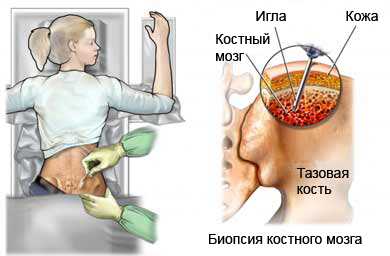Acute myeloid leukemia children – Acute leukemia nelimfoblastnyh children – Acute myeloid leukemia children – OML – Onelli
Description of acute myeloid leukemia in children
Leukemia is a type of cancer, which develop in the bone marrow. In acute myeloid leukemia (OML), the bone marrow makes abnormal myeloid cell, which are precursors of blood cells, including:
- Mieloblastov – White blood cells, designed to fight infections;
- Red blood cells (erythrocytes) – carry oxygen;
- Platelets – thicken the blood, stop bleeding in cuts or bruises places.
Leukemic cells cease to function normally. They can not fight infections. Abnormal cells also begin to grow in the bone marrow, displacing normal. Without normal cells, anemia and begins developing problems, associated with frequent bleeding. Also, the body much at risk of infections.
Causes of acute myeloid leukemia children
Leukaemia is caused by a malfunctioning gene in bone marrow cells.
Risk factors for acute myeloid leukemia children
Factors, which increase the risk of acute myeloid leukemia:
- Genetic factors
- The presence of a brother, especially twin, who is ill with leukemia;
- The presence of genetic diseases (eg, Down's syndrome);
- Exposure to radiation;
- Exposure to certain chemicals (eg, benzene – chemical agent, used in manufacturing);
- Previous blood disease (eg, polycythemia vera, myelodysplastic syndrome);
- Race: Hispanic.
Symptoms of acute myeloid leukemia children
Symptoms include:
- Elevated temperature;
- Frequent infections;
- Breathlessness;
- Paleness (sign anemia);
- Bruising or bleeding;
- Petechiae (small hemorrhages under the skin);
- Weakness, fatigue;
- Loss of appetite, weight loss;
- Pain in the bones and joints;
- Painless swelling in the neck, armpits, stomach, or groin;
- Bleeding gums.
These symptoms may also be associated with other diseases.
Diagnosis of acute myeloid leukemia children
First conducted a physical inspection. The presence of tumors verified by the liver and spleen. Examines the lymph nodes in the armpits, in the groin, in the neck for the presence of tumors.
Further tests may include:
- Blood tests – checking for changes in the quantity or appearance of various types of blood cells;
- Bone marrow aspiration – selection of the sample liquid bone marrow, to check for cancer cells;
- Bone marrow biopsy – selection of the sample liquid bone marrow and a small part of the bone, to test for cancer cells;
- Spinnaya puncture – selection of a small amount of cerebrospinal fluid, to check for cancer cells;
- Microscopic examination – a study of the blood sample, bone marrow, lymph node tissue, or cerebrospinal fluid;
- Analyses of bones, bone marrow, lymph node tissue, or cerebrospinal fluid – to determine the types of leukemia;
- Cytogenetic analysis – analysis, to find certain changes in the chromosomes (genetic material) lymphocytes;
- Immunophenotyping – study of cell surface proteins, and antibodies produced by the body to distinguish from related lymphoblastic myeloid leukemia and determine the type of therapy;
- Chest X-ray – chest X-ray, which may detect signs of infection in the lung or breast cancer;
- Computed tomography - the type of X-ray, which uses computer, to make pictures of internal organs;
- MRT – test, which uses magnetic waves, to make pictures of structures in the body;
- Gallium scan and bone scan – injection of radioactive substances into the bloodstream, to discover the area of cancer or infection;
- Ultrasound (US) – analysis, which uses sound waves, to examine body organs.
Once AML is identified, it can be assigned to one of eight subtypes. These are based on cell type, of which develops leukemia. Classification is very important. It helps to prescribe treatment for each subtype.

Treatment of acute myeloid leukemia children
Treatment of AML typically includes two phases:
- Induktsionnaya therapy – to kill leukemia cells;
- Maintenance therapy – to kill any remaining leukemia cells, which can again grow and cause a relapse.
Treatment involves the following procedures:
- Chemotherapy;
- External radiation (Radiation) therapy – It is intended for a particular body part;
- Stem cell transplantation, replace the affected bone marrow cells healthy;
- Other therapies (eg, trioxide mыshyyaka, tretinoin) may be used, to kill leukemia cells, stop their division, or help develop into mature white blood cells;
- Biological Therapy, It involves the use of drugs or substances, produced by the body to increase or restore the natural defenses against cancer (immunomodulators);
- Antibiotics for the treatment and prevention of infections;
- Medicines to treat anemia and side effects (nausea, vomiting).
Prevention of acute myeloid leukemia children
To date, methods of prevention are unknown.
